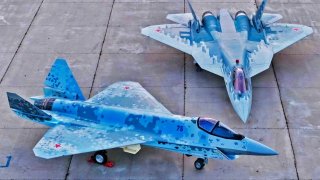Russia's Su-75 Checkmate Stealth Fighter Nightmare Has Now Begun
With the ongoing war in Ukraine consuming Moscow's attention and resources, the Su-75 faces financial challenges, and its development has been slow.
Top 5 Points on Russia's Su-75: The Su-75 Checkmate is one of Russia's latest ambitious defense projects, but its future remains uncertain.
-Unveiled in 2021, this fighter jet is surrounded by conflicting claims about its stealth capabilities.
-With the ongoing war in Ukraine consuming Moscow's attention and resources, the Su-75 faces financial challenges, and its development has been slow.
-Russia has a history of overpromising and underdelivering on military projects, as seen with the T-14 Armata tank and Su-57 Felon fighter.
-Given these precedents, the Su-75 Checkmate may struggle to meet its lofty expectations.
Can Russia’s Su-75 Checkmate Fighter Jet Live Up to the Hype?
Even as Moscow continues to face a meatgrinder in Ukraine, the Russian defense and aerospace industries are churning out new projects.
The Su-75 Checkmate fighter jet is one of the most ambitious Russian projects currently in the works. It is too early to say whether the jet will deliver on Moscow’s lofty promises.
The Su-75 Checkmate
To begin with, it is unclear whether the Su-75 Checkmate will be a stealth fighter jet. Stealth capabilities are essentially the competitive threshold for any future fighter jet.
Su-75 manufacturer Rostec and the Russian Ministry of Defense have been ambiguous about the aircraft’s capabilities. At different points, Russian officials have said the aircraft would have to operate outside enemy air defenses – meaning that it won’t have stealth capabilities – while others insist the Su-75 Checkmate will be stealthy.
Right now, the Su-75 Checkmate program seems stuck in a mire of high costs and lack of funds. Back in November, Rostec announced that it would be starting production of the Su-75 Checkmate soon. But the war in Ukraine demands Moscow’s complete attention and the bulk of its defense spending, and the costs associated with the Su-75 are increasing.
The aircraft was revealed in 2021 during an air exposition show. The Kremlin has been looking for foreign partners to join in the program, notably the United Arab Emirates and India, but without much success.

From 2014 to 2018, Russia was the second-largest exporter of weapons systems in the world, behind the United States. Today, Russia has fallen to third, losing its spot to an ambitious and outward-looking France. The war in Ukraine has done much to harm the image of Russia, but the Kremlin hopes this will change in the future and that Moscow will be able to sell the fighter jet abroad.
A History of Hyperbole and Failure
The Kremlin is infamous for making grand claims about upcoming defense projects. Usually, despite fanfare and promises, these projects underperform. The T-14 Armata main battle tank, the Su-57 Felon, and the Kh-47M Kinzhal hypersonic missile are the most recent examples of Russian defense industry failures.
After years of development and testing, the T-14 Armata has yet to see any combat action in Ukraine, suffering frequent breakdowns and performance issues. The Su-57 Felon is supposed to be a fifth-generation stealth fighter aircraft, but it remains an unknown quantity. The Russian Aerospace Forces have a very limited number of the aircraft, most of which are prototypes that were pressed into service.
Like the T-14 Armata, the Su-57 Felon has been conspicuous in its absence from the fighting in Ukraine. Finally, the Kh-47M is anything but hypersonic, and the missile is getting shot down in considerable numbers by Ukrainian air defenses.
The Su-75 Checkmate is still several years away, and if recent history is a guide, the Russian fighter jet will underperform the Kremlin’s fancy promises.
About the Author
Stavros Atlamazoglou is a seasoned defense and national security journalist specializing in special operations. A Hellenic Army veteran (national service with the 575th Marine Battalion and Army HQ), he holds a BA from the Johns Hopkins University, an MA from the Johns Hopkins’ School of Advanced International Studies (SAIS). He is pursuing a J.D. at Boston College Law School. His work has been featured in Business Insider, Sandboxx, and SOFREP.


